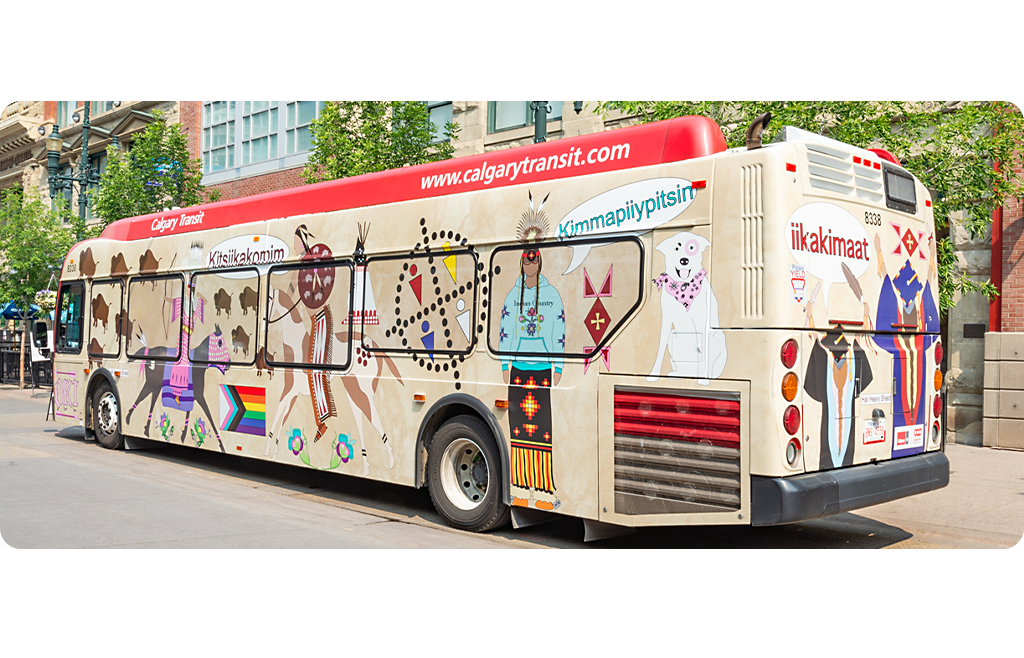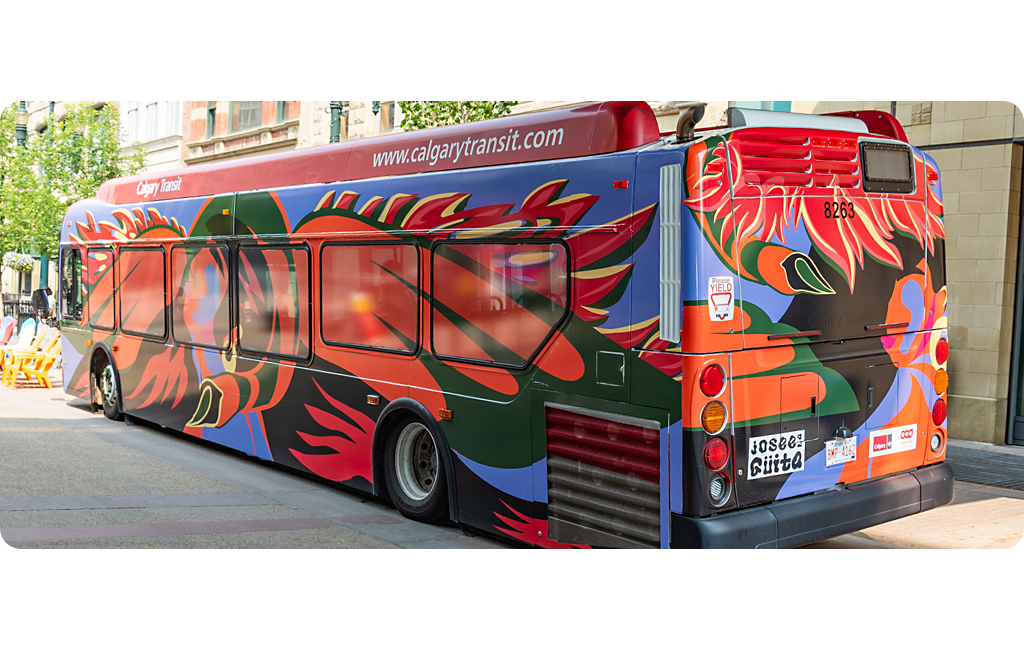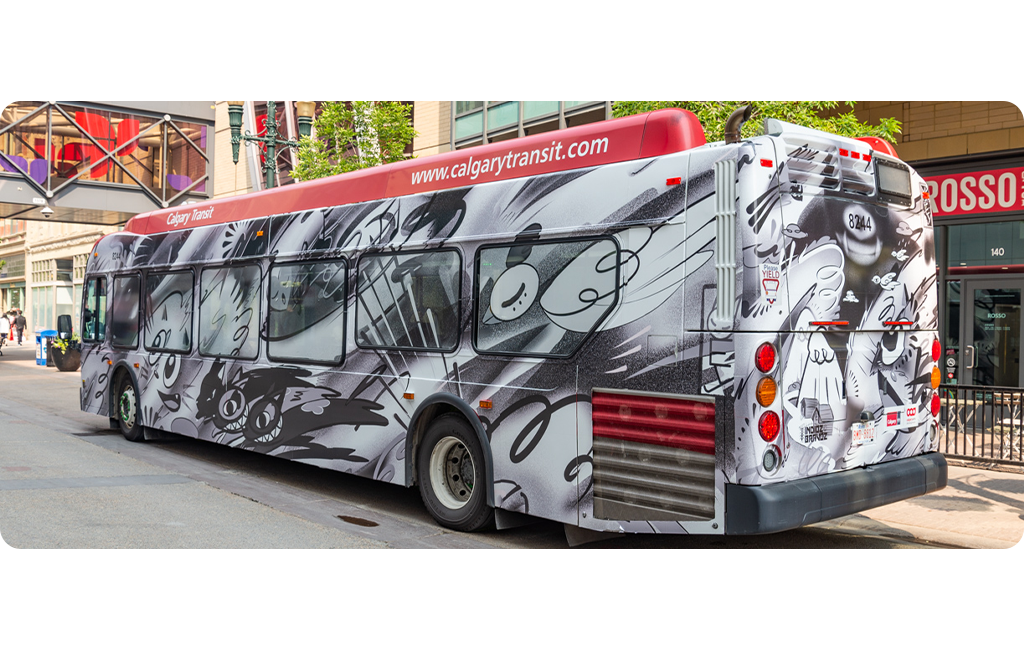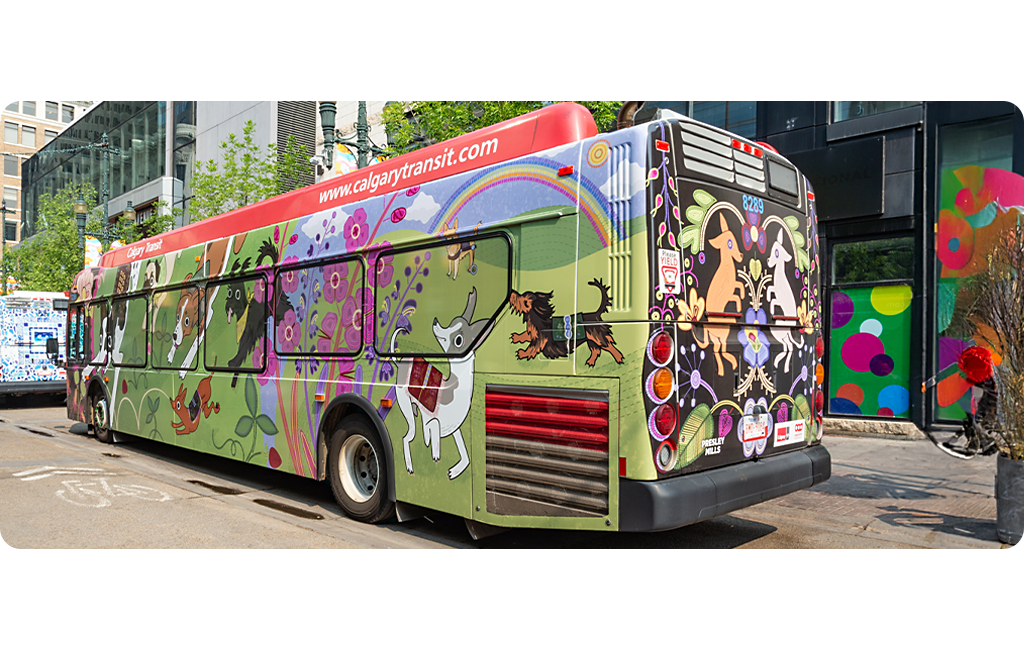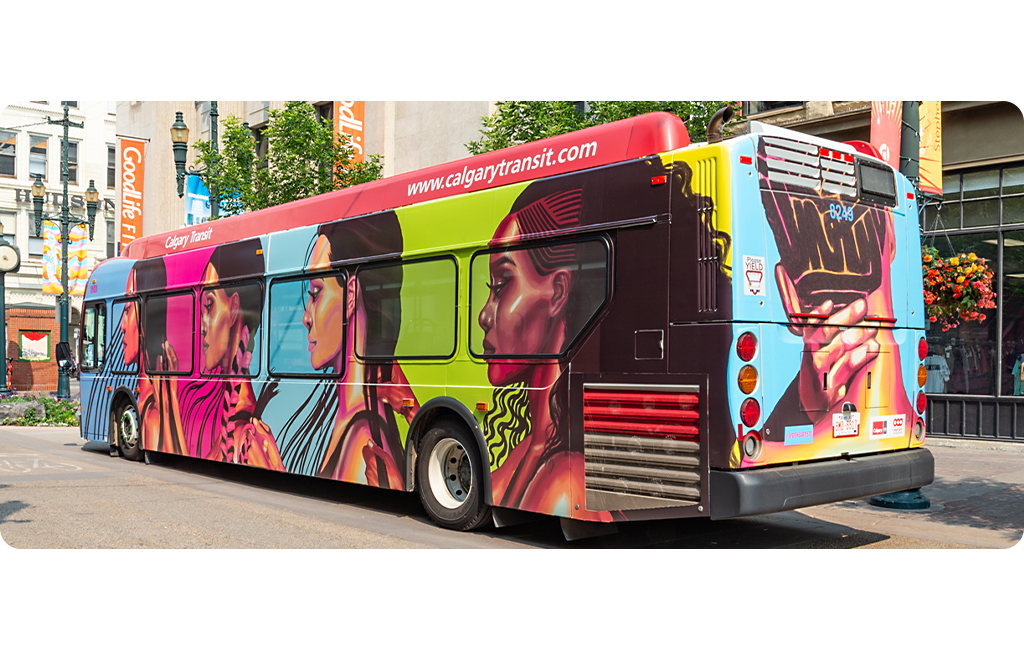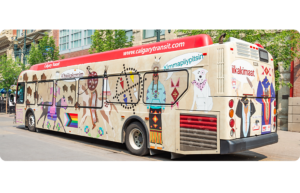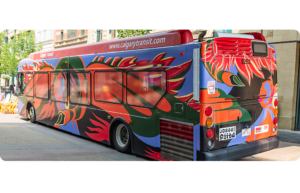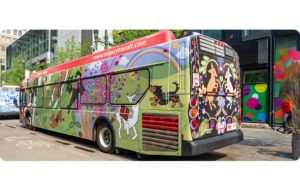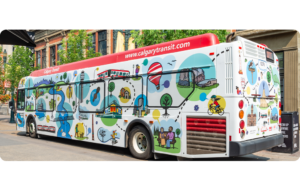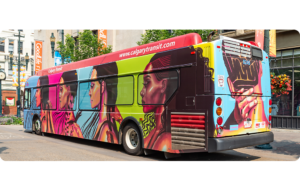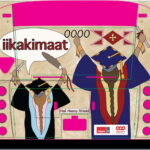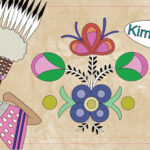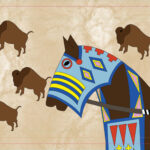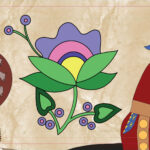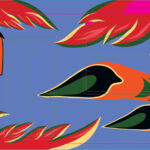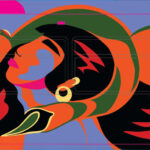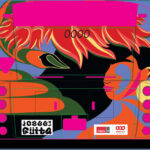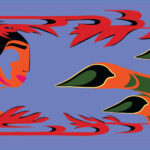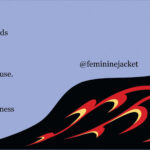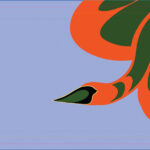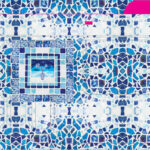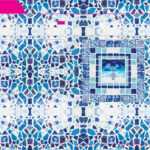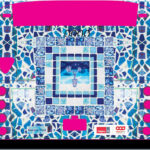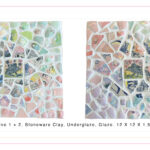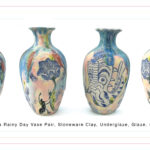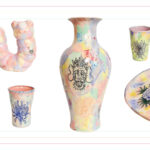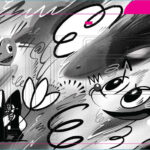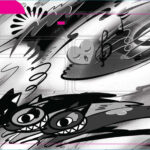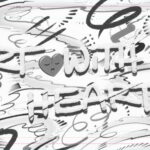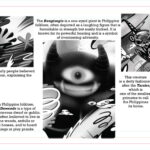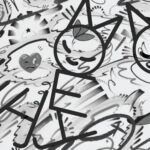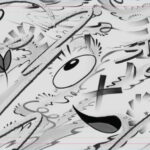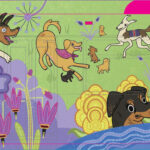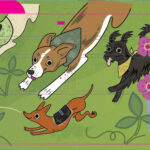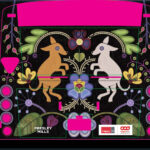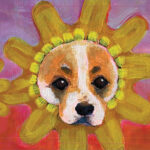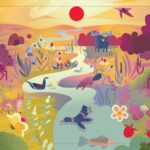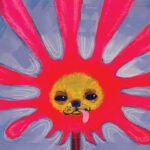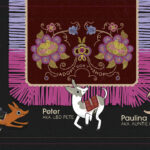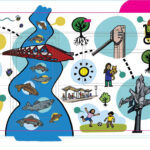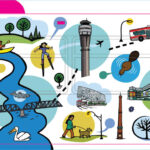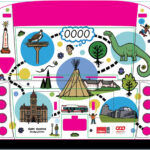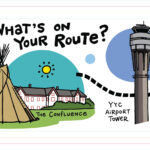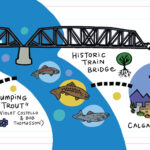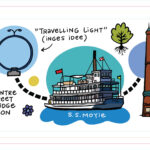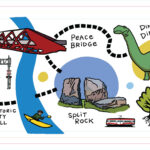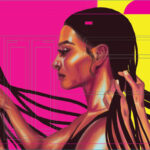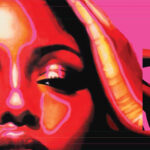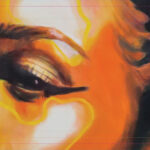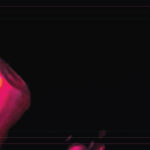The Program
Following the successful launch of the Art Bus Program in 2024, the number of buses for 2025 has doubled — seven local artists/artist collectives have each created an original artwork to wrap on two buses, for a total of 14 buses bringing art directly into the everyday lives of Calgarians. The wrapped buses will travel across city routes for approximately six months starting in May 2025. Each bus also includes printed panels inside, showcasing more of each artist’s work and story.
Selected artists were invited to respond to one of four themes:
- Honour Indigenous stories and perspectives
- Public transit as social space
- Share stories of your community
- Bring beauty, joy, whimsy and hope
This project celebrates Calgary’s diversity, history and geography, while making art more accessible and visible in public spaces. It also provides opportunities for local artists to gain experience in public art and connect with new audiences.
Learn more about the artists and the artworks below. We will be posting photos of the wrapped buses shortly after the public Art Bus Celebration on June 11. You can also watch our video interviews with the artists here.
Want to find an Art Bus? You can track their daily route using their bus numbers on Transit55. The artist bus numbers are: Dr. Hali Heavy Shield (8338 and 8215), Josee La Guita (8263 and 8231), Mao and Chris (8238 and 8247), Moey Blanco (8244 and 8324), Presley Mills (8289 and 8272), Sam Hester (8276 and 8260), Sydonne Warren (8249 and 8331).
Thank you to Pattison Outdoor Advertising for supporting this project.
About the Artists:
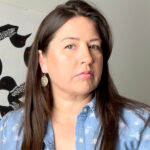
Dr. Hali Heavy Shield
Artist Bio
An accomplished multidisciplinary artist, author, instructor and mentor, Nato’yi’kina’soyi (Holy Light that Shines Bright) or Dr. Hali Heavy Shield (PhD 2024) is the first Blackfoot woman to receive a PhD from Iniskim, University of Lethbridge. A member of the Kainai Nation (Blood Tribe), Hali’s research and art making focuses on the Blackfoot healing ways of storytelling. Her work is influenced by experiences in her home community, including Blackfoot stories, significant sites, family and women as sources of strength and goodness.
Find out more about Dr. Hali’s Art Bus design in this short video.
Artist Gallery
Click images to enlargeArtist Statement
Brothers and Sisters invites viewers into a culturally rich representation of Blackfoot life, values and community. Inspired by Blackfoot art forms like story robes and winter counts, the design celebrated seasonal milestones — such as graduation and the Calgary Stampede — while honouring deep connections to family, culture and the land. The artwork captures a powerful blend of Blackfoot horse culture and contemporary life, showcasing life-size figures that reflect both the past and present of Blackfoot peoples.
The artwork includes a symbolic water tower illustrated with the word ‘Standoff,’ a heartfelt tribute to the artist’s home community, where both history and daily life intertwine. This theme of continuity is further explored through representations of Blackfoot bead, quill and leather work — celebrating the resilience and beauty of Blackfoot craftsmanship and imagination.
Floral motifs enrich the piece, symbolizing growth, renewal and hope for future generations. Together, these elements celebrate the seasons of life, family and community, inviting viewers to reflect on both personal and collective histories and experiences.
Glossary:
Oki: Hello
Iikakimaat: Never Give Up
Tsimaa: Where are you going/Where to?
Kitsikakomim: I love you
Kimapiipitsin: Kindness/Compassion

La Güita
Artist Bio
Bringing magic and folklore to life, La Güita (she/her) is a Calgary-based Nicaraguan Canadian artist whose murals and illustrations burst with vivid colour and movement that lean into the sacredness of identity. Her work transforms public spaces into dreamlike landscapes that celebrate ancestry and joy.
Find out more about La Güita’s Art Bus design in this short video.
Artist Gallery
Click images to enlargeArtist Statement
My concept for the Art Bus is rooted in the quiet and the unseen work we do to heal. While the bus makes its way through the city streets, the imagery stands bold and colourful as a sign:
If you are feeling the weight of uncertainty, the swan has come to guide you inward, urging you to go beyond the surface and explore the depths of your being. Beneath the water’s surface, it holds space, a guardian of transformation, reminding you that healing is already within you. The hibiscus has not yet bloomed, but it will, just as love and abundance flow when you allow them in. Rising above fear is not a battle, but a release, a soft unraveling of what no longer needs to be carried. You are the source of love, the vessel of your own becoming. Let this moment hold you, let the path ahead rise to meet you.
This piece is my offering to the community, a reflection of the beauty, joy and hope found in honouring the small moments that shape who we are. Reconnecting to our deepest self requires honesty, resilience and the courage to release what no longer serves us. Give yourself the time to bloom, allow yourself to feel.

Mao and Chris
Artist Bio
Mao (Kun) Chen and Chris Savage, collectively known as Mao and Chris, are artists based in Calgary. Their collaborative work spans ceramics, paintings and public art. Mao and Chris delve into themes of identity, diversity and societal change, bridging cultural gaps through their art. They merge traditional and pop culture elements to explore personal and cultural narratives, fostering cross-cultural communication and offering rich, layered interpretations that resonate across a wide audience.
Recognized with several grants and awards from prestigious bodies such as the Canada Council for the Arts and Calgary Arts Development, Mao and Chris have been lauded for their contributions to advancing contemporary ceramic art and fostering meaningful dialogues within the art world. Additionally, both artists have expanded their perspectives and enriched their practice through various international residencies and exchanges, including the Deer Lake Artist Residency in Burnaby, B.C. and the Royal College of Art Exchange in London, U.K. Their work is held in private and public collections across Canada, the U.S. and in Asia.
Find out more about Mao and Chris and their Art Bus design in this short video.
Artist Gallery
Click images to enlargeArtist Statement
We are Mao (Kun) Chen and Chris Savage, a collaborative artist duo based in Calgary/Mohkinsstsis, united by a shared commitment to exploring cross-cultural narratives through contemporary ceramic and public art. Our artistic practice combines our distinct cultural backgrounds — Mao’s Chinese heritage and Chris’s Canadian roots — and integrates these perspectives into our ceramic works, which range from functional pottery to large sculptural pieces. Our work is informed by the rich histories of art and craft from both Eastern and Western traditions.
Our approach is deeply collaborative, involving dynamic conversations and the blending of hand-building techniques, intricate glaze work, and conceptual exploration. Each piece reflects our journey — an ever-evolving dialogue between cultures, personal histories and shared human experiences.
For this project, we chose the theme of ‘Public Transit as Social Space.’ We selected two symbolic flowers: the peony, China’s national flower representing beauty and unity, and Alberta’s wild rose, emblematic of resilience and local pride. Inspired by traditional blue-and-white porcelain, we created tiles and mosaic panels using ceramics glazed in various shades of blue. Each tile and ceramic fragment come from a different firing method, reflecting the diverse backgrounds and journeys of Calgary’s transit riders who come together daily.
Our art practice is a journey of experimentation, dialogue and connection. We are grateful for the opportunity to contribute to Calgary’s public art landscape and to share our story with the city’s diverse communities. By transforming a bus into a mobile piece of art, we invite viewers to experience the power of art as a connector of cultures, ideas and people. We hope this installation will inspire reflection on the beauty of diversity, the strength found in unity and the power of public art to build connections in our urban landscape.

Moey Blanco
Artist Bio
My name is Moey Blanco, a full-time artist based in Calgary. As part of the Japanese postmodern art movement known as Superflat — with artistic influences including Takashi Murakami and Yoshitomo Nara — my work blends two-dimensional graphic design, countercultural street art and the reflective depth of fine art to explore ideas of introspection and community. My love for the simplicity of cartoons has also become influential in my works featuring whimsical characters, striking lines and bold compositions.
My current focus is celebrating the diversity of Filipino culture and art through my collective, Indioz Bravoz. Co-founded with Calgary and Vancouver-based artists such as Mar Cortez, Mae Facundo and Harvey Nichol, our goal is to spotlight our heritage and bring artists together from across the Western diaspora.
From murals and installations to apparel and exhibitions, my art has been showcased locally and internationally.
Find out more about Moey’s Art Bus design in this short video.
Artist Gallery
Click images to enlargeArtist Statement
During my travels in the Philippines, I spent a good amount of time in Manila. Unlike the islands, where landscapes are painted in lush greens, deep browns and warm oranges, the city is a vast expanse of grey — concrete buildings, cement-paved roads and smog billowing from jeepneys.
Cementology is the study of cement and concrete — their mixing, setting, hardening and inevitable cracking. For my Art Bus, I translate my experiences in Manila into a greyscale composition, stripping away chroma to focus on the raw textures and structures that shape the city. Mixing this concept with my practice should result in an intriguing display of how the absence of colour can still evoke joy and vibrancy. Through this piece, I’ll explore how different elements — both literal and cultural — mix, set, harden and eventually crack, revealing the complex and vibrant layers of my experiences in Manila.

Presley Mills
Artist Bio
Since graduating from Alberta University of the Arts, Presley has been working on a variety of projects that include branding, art direction, illustration, advertising and publishing. She currently works as the Creative Services Director at pipikwan pêhtâkwan. Her creative philosophy centres design as visual storytelling; combining arts and research practices. Art is her way of learning and sharing more about the world — specifically, exploring themes of Indigenous identity, decolonization, lessons from the natural world and art as space for both joy and grief.
Find out more about Presley’s Art Bus design in this short video.
Artist Gallery
Click images to enlargeArtist Statement
The illustration for my Art Bus celebrates all the rescue dogs that have made an impact on my life and, in small and big ways, become a part of my family. Each dog depicted is inspired by a real dog rescued here in Calgary. The Métis, known as ‘the flower beadwork people,’ show pride and honour family through their beadwork. Li Tāpis’ (meaning ‘small carpet’) named by the French Michif and known as ‘tuppies’ by the English and Scottish Michif, are traditional dog blankets. Historically, these wool blankets were decorated with beadwork, silk embroidery, ribbon, yarn, bells and pompoms. To honour my dog friends, each is adorned with a tapis or kokom scarf. The beadwork-inspired landscape is filled with native plants found in Calgary, such as blue-eyed grass, buffalo bean, fireweed, Jacob’s ladder, nodding onion and wild strawberry.
Fostering rescue dogs has taught me resilience, patience and compassion — lessons I’ve also learned from beading. This combination of dogs, art and nature has been a form of medicine for me. I hope the silly dogs on this bus make folks smile. I hope it sparks some curiosity about making a rescue animal a part of their family.
The concept was inspired by the work of Adele ᒪᐢᑿᓱᐤᐃᐢᑵᐤ Arseneau.

Sam Hester
Artist Bio
Sam Hester makes comics that tell real-life stories rooted in Calgary/Mohkinsstis. Sam uses the medium of autobiographical comics as a tool for community-building: local stories can be great connectors that get people talking about places and their history. You can find Sam’s comics at the Calgary-based local independent journalism outlet The Sprawl.
Since 2014, Sam has also worked as a graphic recorder, one of only a handful in Canada. Listening deeply, she documents live events, creating “illustrated meeting minutes.”
Sam’s 2021 TED Talk about Graphic Medicine (using visual storytelling to support health care communication) has had almost two million views.
Find out more about Sam’s Art Bus design in this short video.
Artist Gallery
Click images to enlargeArtist Statement
My Art Bus concept is inspired by the theme “Share stories of your community.” I like to make art that gets people curious about where they live. I want viewers to ask questions about where they’re from, and why that place is the way it is. My concept is a depiction of a Calgary Transit bus making its way through Calgary/Mohkinsstsis (represented by a bunch of well-known city landmarks). A bus ride is an opportunity to be an explorer in your own city! If you become curious about your local setting, you start to care about that place and to feel connected to it.
I hope that some of the landmarks in my picture might spark recognition, even among viewers who are new to Calgary. For viewers who know the city well, I hope to create curiosity about the landmarks they don’t know, encouraging them to learn more.
I’ve chosen city landmarks that are mostly well known, but everyone’s bus ride includes personal landmarks that are part of their own private experience of the city. Maybe this picture could inspire transit riders to create or share some of the highlights of their own bus journeys. When we experience another person’s journey, we get a glimpse of a whole new city. Calgary/Mohkinsstsis is unique for each of us, and I hope to get people curious about how others experience it. Why? Because curiosity is the first step toward empathy, and encouraging empathy is one of my main goals as an artist.
Calgary/Mohkinsstsis Landmarks: What’s on your Route?
Broadcast Tower
The 140-metre (459-foot) CTV tower was erected in the 1960s and still stands on Broadcast Hill in the neighbourhood of Coach Hill-Patterson Heights.
University of Calgary Arch
In the late 1960s, a curving pedestrian bridge spanned Crowchild Trail, connecting the University of Calgary campus to the neighbourhood of Capitol Hill. Known as the Rainbow Bridge, it was due to be dismantled in 1986 to make way for a new LRT station. The steel arch was transported to the University’s 24 Avenue NW entrance. Now painted red, it still stands there today.
Canada Olympic Park
Five ski jumps were built at Canada Olympic Park for the 1988 Olympic Winter Games. Today, the largest tower at 90 metres (295 feet) is the departure point for North America’s fastest zipline.
Travelling Light
This 2013 sculpture, created by the artist collective inges idee, is located on 96 Avenue NE.
Peace Bridge
The Peace Bridge, which opened in 2012, crosses the Bow River on the north side of Calgary’s downtown.
Jumping Trout
The Jumping Trout sculpture consists of 144 fish, integrated into the walls of the underpass at Glenmore Trail, Elbow Drive and 5 Avenue SW. The work was installed in 2007 and created by artists Violet Costello and Bob Thomasson.
Conversation
This popular sculpture by William Hodd McElcheran has been located on Stephen Avenue (8 Avenue SW) since 1981.
The Military Museums
From Crowchild Trail, you can see a CF-5 Freedom Fighter on display outside The Military Museums. It was built by Canadair in Montreal, Quebec in 1968, and last flew in 1995. It has been on display at the Museum since 2007.
(Source: www.themilitarymuseums.ca)
Calgary Tower
Originally named the Husky Tower, the 191-metre (626-feet) structure was completed in 1968. Underneath the tower, there was a passenger train station called Palliser Square Station. Since 2000, the station has been out of use, but it’s still there! The tower was renamed the Calgary Tower in 1971 and has become the city’s most recognizable landmark.
Centre Street Bridge Lion
Four lion sculptures were installed in 1917 to watch over the north and south ends of the Centre Street Bridge. The artist was James L. Thompson, a Scottish-born stonemason who worked for the City of Calgary. He modelled the lions after the bronze lions at the base of the Nelson monument in London’s Trafalgar Square. The lions on the Centre Street Bridge today are replicas of the originals, which were damaged over the years. One of the original lions was restored and is on display inside Calgary’s Municipal Building. Another can be found at Rotary Park.
Firestone Tower
The 61-metre (200-foot) tower was part of the Firestone tire factory, located on the hill overlooking Deerfoot Trail and Memorial Drive NE. The plant shut down in 1978, but the tower remains.
S.S. Moyie
Heritage Park’s S.S. Moyie is a half-size replica of a historic 1898 paddler wheeler ship.
Historic Railroad Bridge
This bridge, in the Bonnybrook Industrial Area, was built in 1911 by the Grand Trunk Pacific Railway. Today it’s used by CN (Canadian National Railway Company).
Airport Control Tower
In 2013, the new Air Traffic Control Tower opened at Calgary International Airport. At 91 metres (300 feet), the tower was the tallest free-standing control tower in Canada.
Central Library
Calgary’s Central Library, in the East Village, opened in 2018.
Eau Claire Smokestack
The brick smokestack at the intersection of 2 Avenue and Barclay Parade SW is all that remains of the Calgary Transit System Garage, which housed Calgary Transit’s original maintenance and storage facilities from 1947 until 1988. The historic tower is 27 metres (90 feet) high.
Alberta Children’s Hospital
The Alberta Children’s Hospital, located west of the University of Calgary, is the largest children’s hospital in the prairie provinces. It opened in 2006.
Split Rock
Split Rock can be found in West Nose Creek Park. This glacial erratic was once part of Mount Edith Cavell in Jasper National Park.
Contemporary Calgary
Contemporary Calgary is a modern and contemporary art gallery, located in the former Centennial Planetarium at the west end of the downtown.
Osprey Platform
There are a few osprey platforms in the city: for example, at Fish Creek Park and on 25 Avenue SE near the City of Calgary Water Centre Ospreys return to them in the spring, nesting there during the warm weather months.
Calgary City Hall
Calgary’s sandstone City Hall was built between 1907 and 1911 (replacing an 1885 wooden building that stood on the same site). The historic building was extensively renovated between 2016 and 2020.
Telstar Drugs Sign
Telstar Drugs was a local business that opened in 1962, and was located on the corner of 14 Street and Kensington Road NW. The business was sold in 2004, and its large neon sign was donated to the Glenbow Museum in 2006.
Dinny the Dinosaur
Dinny is a concrete brontosaurus sculpture that was built at the west end of St. George’s Island in 1937. Dinny is 12 metres (36 feet) tall and 36 metres (118 feet) long and weighs 110,000 kilograms. You can still find Dinny at the Calgary Zoo, the only remnant of the Zoo’s original Natural History Park that was conceived and developed during the Great Depression. Dinny was designed and built by Finnish-born artist John Kanerva.
(Source: https://mycalgary.com/city/historic-calgary/dinny-the-dinosaur/)
The Confluence
In 2024, Fort Calgary changed its name to The Confluence Historic Site & Parkland. The Confluence is located at the place where the Bow and Elbow rivers meet. Long before the North-West Mounted Police arrived in 1875, Indigenous peoples have been gathering on this land from time immemorial.
(Source: www.theconfluence.ca)

Sydonne Warren
Artist Bio
Sydonne Warren is a muralist, entrepreneur and community builder whose work is all about celebrating culture and making a real impact. Originally from Jamaica and now living in Canada, she’s spent the last four years transforming public spaces with large-scale murals that honour diversity and amplify underrepresented voices. With deep roots in her Caribbean heritage and the stories of Black women, Sydonne’s art is full of vibrant colours and expressive figures.
Her murals can be seen in Calgary, turning ordinary walls into powerful stories of resilience, empowerment and unity. For Sydonne, art is a tool to unite people and she’s committed to using it to foster connection. Some of her murals are collaborative efforts, created alongside residents and youth, blending her artistic vision with the voices of the community. This approach ensures the art is not only reflective of her style but also inclusive of the people it represents.
Sydonne is passionate about teaching and mentoring through art.
Sydonne continues to inspire and strengthen communities, turning blank walls into symbols of hope and unity. Her goal is always to empower others to see the transformative power of public art, creating something that not only beautifies a space but also leaves a lasting impact.
Find out more about Sydonne’s Art Bus design in this short video.
Artist Gallery
Click images to enlargeArtist Statement
Interwoven is an artwork that unites women from different cultures through the shared tradition of hair braiding. Each woman featured in the artwork wears a distinct braided style rooted in her heritage, while another woman from a different cultural background braids her hair. This act of connection forms a continuous human chain, symbolizing the beauty of diversity and interdependence.
At the back of the bus, an intricate braided design spells out the word ‘UNITY,’ reinforcing the message that, despite our differences, we are all linked by shared experiences and traditions. Hair braiding, a practice deeply woven into many cultures worldwide, becomes the visual and symbolic thread binding these women together.
Each figure is painted in bold, vivid skin tones, contrasting against a bright backdrop. This colour palette emphasizes both the individuality of each woman and the richness of their cultures, while also highlighting the distinct braided styles that set them apart.
The act of one woman braiding another’s hair is a gesture of trust and care. The artwork challenges divisions and invites conversations about the ways we are all interwoven as part of a larger human tapestry.
Featured braids and cultural significance:
Indigenous Braids
Indigenous braids resemble sweetgrass braids and symbolize the unity of mind, body, and spirit. Braided hair represents a connection to the earth, while loose hair signifies a connection to the spirit. These braids embody strength, wisdom, identity and a link to ancestors. In Indigenous cultures, cutting hair is a significant act reserved for mourning, marking a period of loss and transition.
West African Cornrows
Cornrows have their origins in Africa and serve both practical and symbolic purposes. They protect the hair from harsh elements while also conveying vital cultural information. Cornrows can indicate a person’s tribe, age, marital status, wealth, power and religion. During slavery, they were ingeniously used to communicate escape plans and carry important messages, demonstrating the resilience and resourcefulness of African communities.
Indian Braid
In Indian culture, braids can signify socio-economic status and carry deep cultural meaning. Loose hair is considered sensual, while braided hair reflects structure and modesty. Hair care practices include applying oils for nourishment and fragrance. On special occasions like weddings, flowers, garlands and ornaments are woven into braids to symbolize love, purity, luck, social standing and regional identity.
European Crown Braid
The European crown braid is a versatile hairstyle with roots in many European cultures. Initially, it served the practical purpose of keeping long hair secure during farm work. Over time, it evolved into a fashionable statement, worn by women of high social status to showcase their elegance and refinement.
French Braid
The French braid, associated with French aristocrats in the 1800s, actually traces its origins to both Greek and African cultures. Known for its elegance, versatility and creativity, the French braid became a symbol of sophistication. Long, elaborately braided hair was considered a source of pride, demonstrating both beauty and status.
Tibetan Braids
In Tibetan culture, braids carry profound meanings related to roots, beliefs, social roles and religion. They are often adorned with ornate jewelry and worn during significant life milestones such as giving birth, coming of age, marriage and death. Men and women grow their hair without cutting it. After death, hair is cut and burned. Braiding also keeps hair neat during the nomadic lifestyle, reflecting practicality intertwined with cultural expression.
Mexican Braids
Mexican braids are deeply rooted in identity, beauty and marital status. Two side braids tied with ribbons represent Indigenous heritage, while the number and positioning of braids signify marital status. The style also serves a practical purpose, keeping hair tidy while working. These braids are a vibrant expression of cultural pride and personal identity.
Ethiopian Albaso Braids
Originating from the Tigrinya ethnic group, Albaso braids hold significance in Ethiopian culture. They indicate ethnicity, tribe, marital status and social standing. Often worn during special occasions like weddings and celebrations, these intricate braids showcase cultural heritage and artistic expression through their unique patterns and styles.
